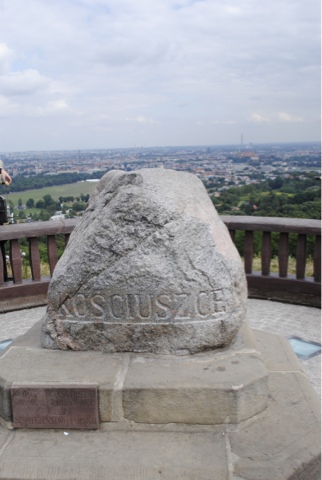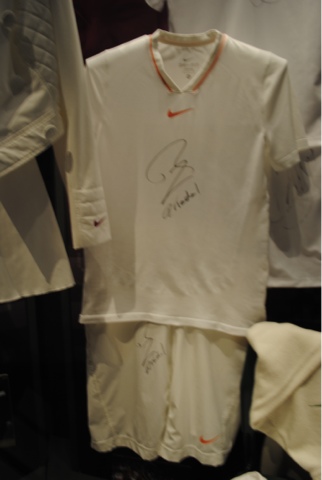This Blonie used to be covered with water and there was an island in the middle of the water.
A long time ago this was so, my friend said.
A little further on we went by the Klasztor Norbertanek (monastery of sisters) and up the hill to 2 small churches. Both are only open for mass. The white church was dedicated to Saint Salwator and the wooden church was to Saint Malgorzata (Margaret). Here is that octagonal wooden church with statue of Pope John Paul II outside.
As we climbed up the street we saw a very pretty cemetery on a hillside. Its name is Salwator. There were very old and new tombstones packed very close together. Some were family graves. I asked my friend about how one gets a burial place there. You pay the city for a plot over a 20 year period. That is what I understood. There were some unmarked graves. It is possible that the city buried people there who perhaps were not claimed by their family (no family left or neglected by family). My friend told me about 2 of her students and their father who were killed in a car accident and were buried there.
In Poland the coffins are above ground and are not completely buried like in the States.
We walked past some "dzialki" (community gardens). The land is owned by the city. You can buy a lot and grow your own garden. You can also build a small cottage on the property. You can put a bed in it and sleep overnight if you wish. It is not a big building and it is pretty bare. I think my pianist in Cracow has one of these gardens with a cottage somewhere outside of Cracow. She has told me it is a nice place to escape.
Further on up the hill is a walled off area where some rich man is building something. We peeked in but could not tell what will be built there. This man has something to do with a business called "Telefonika" (having to do with telephone cables). That business helps to sponsor the soccer team Wisla Krakow. My friend thinks that he somehow finagled permission to build up there. It is in a woodsy area that should be protected from development.
Then we finally get to the grounds of the mound. There is a huge fortress surrounding it. The Austrians built such fortresses around all of Cracow between 1840-1916. They were places of defense to protect the city of Cracow. Remember that there was a long period when Poland was split up and owned by other countries (until 1918). It ceased to exist as the country of Poland. The area around Cracow was ruled by the Austrians. Hence these Austrian forts. My friend said there is 1 fort in Nowy Kleparz area of Cracow that is now a wine cellar and shop. Another fort in Nowa Huta (a suburb) is a cultural center. We saw many maps and pictures of these fortresses. Some are in need of repair and are for sale. There are certain rules like making sure that part of the building is open to visitors. I have an idea of buying an old fortress and renovating it to make a small concert hall. I am sure the city has restrictions on renovation and usage. Maybe it is not that easy to do.
The mound itself was built between 1820-23 before the fortress was built around it (around 1860). It is in honor of the Polish patriot Tadeusz Kosciuszki. People brought piles of dirt from all over the world to make this monument (even from the US). I saw a photo in the museum there with a box of dirt labeled from the state of Ohio. The Austrians allowed people to visit the top of the mound at first. Later they closed it off to visitors soon after they built the fortress, I think. Sometime later it was reopened to visitors. I remember in the late 90s it was closed to visitors because it had been destroyed by bad weather (lots of rain). Now it is fine and grass is growing. In fact it looks a little unkempt. Last time I was there about 8 years ago the mound was getting a "haircut" (getting mowed). It needs a haircut now. I mentioned that in the guest book in the museum (anonymously!).
There are nice views of Cracow from the cafe up on top of the fortress, as well as nice views from the top of mound. Here are some nice views from the top of the mound and on our way up.
There was a very interesting museum downstairs about Kosciuszko. They had an exhibit of money that had been donated for the upkeep of the mound. This money was either very old and not worth anything or was counterfeit. There were huge figures of Kosciuszko and George Washington sitting at the same table. Two things stood out for me. One was an old photo of a fair called "rekawka". There is another older mound named "Krakus". Legend has it that people were dressed in long sleeves and collected food in their sleeves. The food was thrown at them by rich people who were on top of the mound. Later it became more of a fair with entertainment. It still happens the Monday after Easter over by the Norbertanek monastery. The other thing was an ancient tall statue from the 9th or 10th century. It has 4 different faces on all 4 sides of pre-Christian gods ( of Slavic origin). It represents the 4 sides of the world. Around 1000 AD it was taken and buried in the area of the current Ukraine. I do not remember why it was taken away. Maybe when Christianity became popular here. It ended up near a river in the Ukraine that had changed its course and the water was destroying the statue. It was found by a few boys in the 1840s (?) and returned to Cracow. A replica of the statue is downstairs in the museum. Part of the original is in an archaeological museum here in Cracow.
There was a large figure of Kosciuszko with a sword in his hand and blood on his arm. A tour guide was there explaining to a group of Russians (in Polish) that Kosciuszko went to the US 2 times. One time was to help us get our independence. The 2nd time was around 1794 when there were these Kosciuszko insurrections. He was getting in trouble with the Russians and got hurt in battle. The Russians took him prisoner for a few years and then let him go. He was not allowed to return to Poland, so he ended up in the US again briefly.
Also near the museum is another exhibit of wax figures. They are of famous Polish people like Pope John Paul II, Kosciuszko, Chopin, writers Sienkiewicz and Mickiewicz, sister Faustyna (founder of a Catholic sect) and others. Really interesting down there in the basement is a cistern that collected water for drinking and other uses when the fortress was in use as a military base. There was a filtration system down there where water was cleaned/filtered going through a pile of stones.Sometime later the surrounding walls suffered water damage. Now everything has dried out and has been renovated.
There is also a bunker. It looked rather bare and uncomfortable.
Here is a wax figure of the former pope (with a little blatant advertising!).
I think that is all to say about my visit to the Kosciuszko Mound. As I mentioned there is also the Krakus Mound (much older). There are 2 others -1 named after General Pilsudski and the other a figure of a legend called "Wanda" who threw herself off the mound and killed herself. I can't remember all the details of why. These mounds are located in various places around Cracow. The most impressive one is Kosciuszko's.
I really recommend a lengthy visit in this area of Zwierzyniec that includes our walk up the hill and the Kosciuszko Mound. There is a lot to take in!

















































